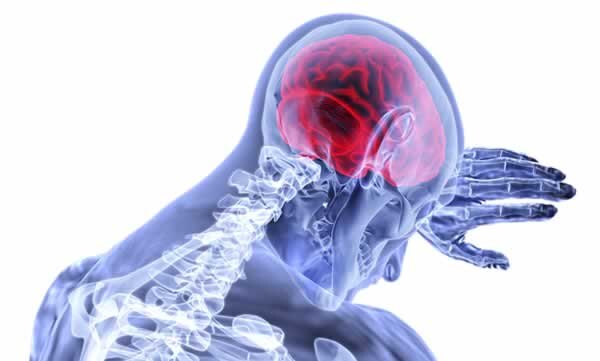When you think of pain, you probably think of your body. It turns out that all pain is interpreted and processed in the brain.
It is easy to distinguish acute pain from chronic pain. Acute pain usually resolves within 3-6 months of an injury as the tissue damage repairs itself. It often leaves no residual evidence. Chronic pain persists.
Pain can be divided into four categories: acute, inflammatory, neurogenic, and central sensitization, more commonly known as chronic pain.
Chronic pain is pain that persists after tissue healing has occurred. It lingers regardless of the fact that no new evidence of injury or a problem persists. It is a complex multidimensional problem with many variances.
1. Acute pain is associated with an injury. It is protective, warning us to move away from the source of the problem. This is known as nociceptive pain, a noxious or obnoxious stimulus.
2. The next type of pain is commonly known as pain related to the inflammatory response. Inflammatory cells surround the areas of tissue damage and produce substances that facilitate the healing and regeneration of tissue repair.
3. A third, less common type of pain is called neuropathic pain, which results from an insult to the nervous system. The injuries usually occur in the peripheral nervous system like carpal tunnel syndrome, neuralgia, sharp shocking pain that follows the pathway of the nerve, and diabetic neuropathy associated with diabetes.
4. The least commonly understood kind of pain is the chronic pain of central sensitization.
Central Sensitization
Central sensitization is a condition of the nervous system associated with the development and maintenance of chronic pain. The confusing part of this condition is that pain itself can change how brain works, resulting in more pain with less provoking stimuli. It does this by modifying the way our brain perceives and processes the pain-provoking stimuli.
All pain is perceived and processed in the brain. This is mind-boggling because we sense that we feel it in our bodies. But it actually happens in the brain and spinal cord, or our central nervous system. Sensitized patients are not only more sensitive to things that hurt, but tend to feel pain to ordinary touch and pressure.
Central sensitization occurs through a process called wind-up, leaving the involved part of the nervous system in a state of high reactivity. This high reactivity lowers the threshold for what causes pain and leads to maintaining pain even after the initial injury has healed.
What causes this to happen?
When we look at a biopsychosocial model we can see that central sensitization is influenced by biological, psychological, social, and environmental predisposing factors.
You might have some genetic factors that predispose your central nervous system to become more reactive.
Psychophysiological factors include the way your stress-response influences your pain perception and experience. For instance, everyone has experienced first-hand how much more their pain tolerance is challenged when they are feeling stressed or emotionally upset.
Moreover, you might have a tendency towards anxiety or depression. Both of which can influence pain thresholds.
There may be a history of trauma too, which underpins your centralized sensitization. Finally, you may have avoidance patterns, especially related to activity and exercise, driven by fear, which contributes to central sensitization as well.
Poor sleep is also a common consequence of living with chronic pain. It is associated with increased sensitivity.
How do you know if you have central sensitization?
Pain persists beyond expected tissue healing/pathological recovery times.
Pain is disproportionate to the nature and extent of injury or pathology.
Widespread, non-anatomical distribution of pain exists.
History of failed interventions (medical/surgical/therapeutic) is a factor.
Negative emotions, poor self-efficacy, maladaptive beliefs, and pain behaviors, altered family/work/social life, medical conflict are at play.
Unresponsive to NSAIDs and/or more responsive to anti-epileptic (e.g. Lyrica) /anti-depressants (e.g. Amitriptyline) medication.
Pain that is easily provoked or takes a long time to settle.
Tendency towards catastrophization of the pain by which you engage in fear-avoidance behaviors or experience undue distress
Constant/unremitting pain exists.
Widespread, non-anatomical distribution of pain occurs.
What are some of the treatment approaches for central sensitization?
1. Patient education is fundamental to the treatment of central sensitization. Cognitive behavior therapy approaches have been found effective. Learning ways to change maladaptive illness/injury perceptions, altering maladaptive pain thoughts and behavior patterns, and reconceptualizing your pain are some of the most effective ways to begin to combat the distressing effects of central sensitization.
2. Somatically based psychotherapy is key to learning mindfulness, meditation, body scanning, relaxation techniques, and most importantly, diaphragmatic breathing. This type of breathing helps calm down the part of the nervous system most closely linked to our emotions, our autonomic nervous system.
3. Regular mild aerobic exercise to reverse the negative effects of deconditioning due to fear is essential.
Persistent, cycling pain patterns
Pain Cycling vs. Pain Recovering
Images From: http://www.backexperts.co.uk/
The negative effects of central sensitization are disturbing and can lead to chronic pain. My integrative approach to treating central sensitization is derived from my combined physical therapy and somatic psychotherapeutic approaches. For more comprehensive information about central sensitization I invite you to explore the following resources, read my page on chronic pain, and reach out for some support.
Explain Pain, David S. Butler, G. Lorimer Moseley
Click here for more information on Chronic Pain Management
I invite you to contact me here for more information. You can ask me any questions you may have about chronic pain counseling and my practice.






